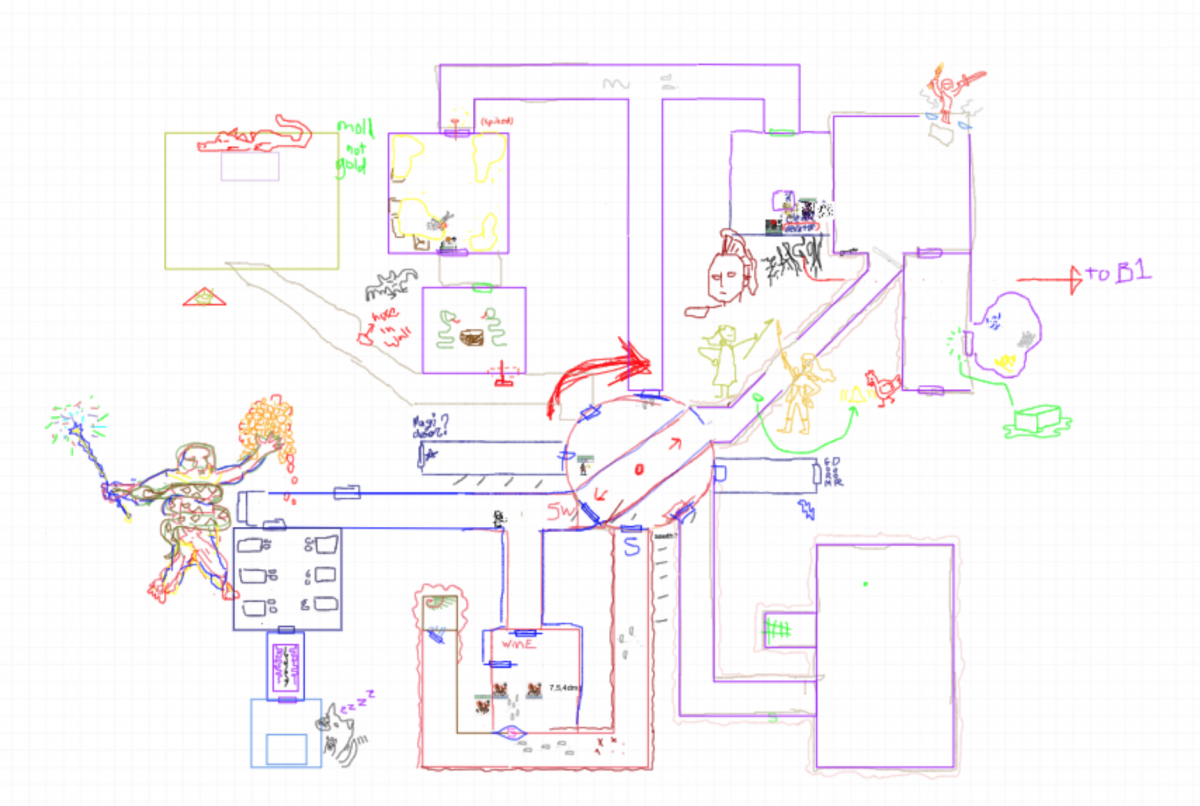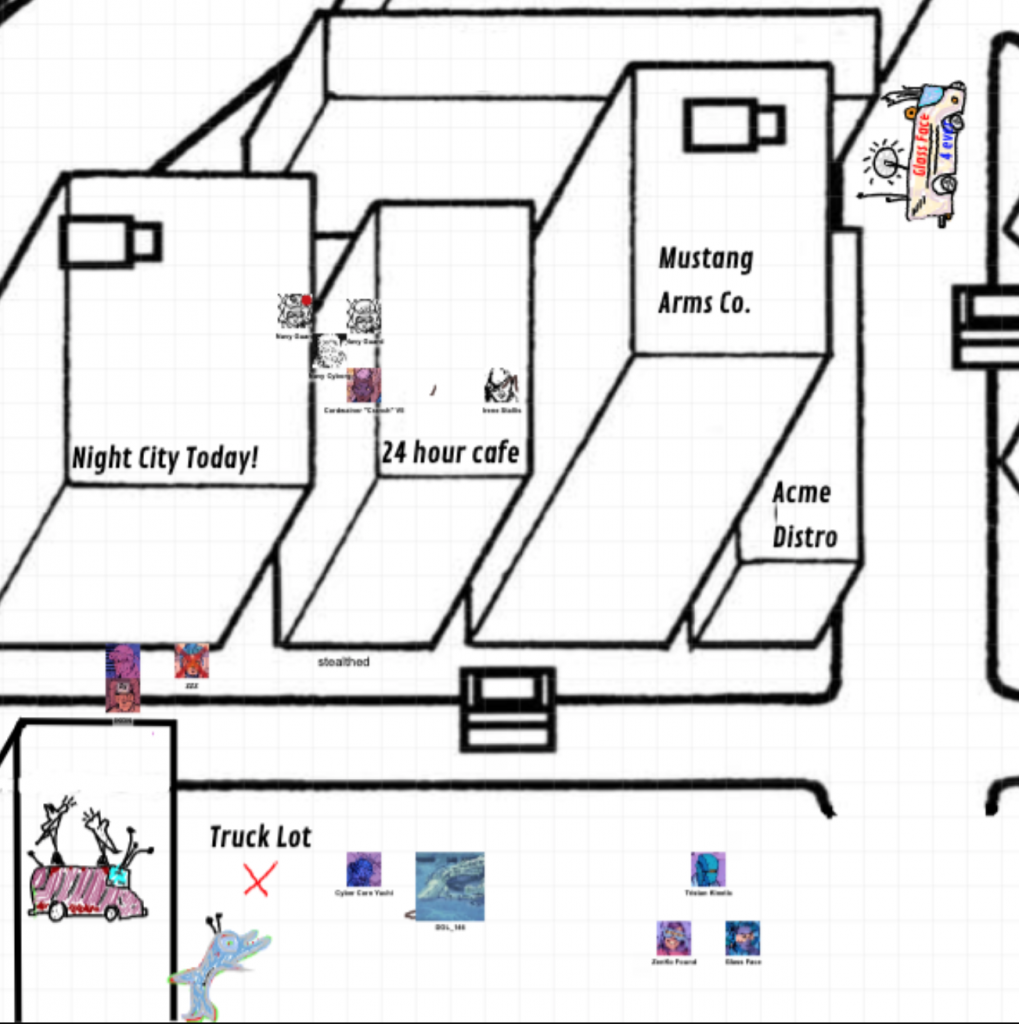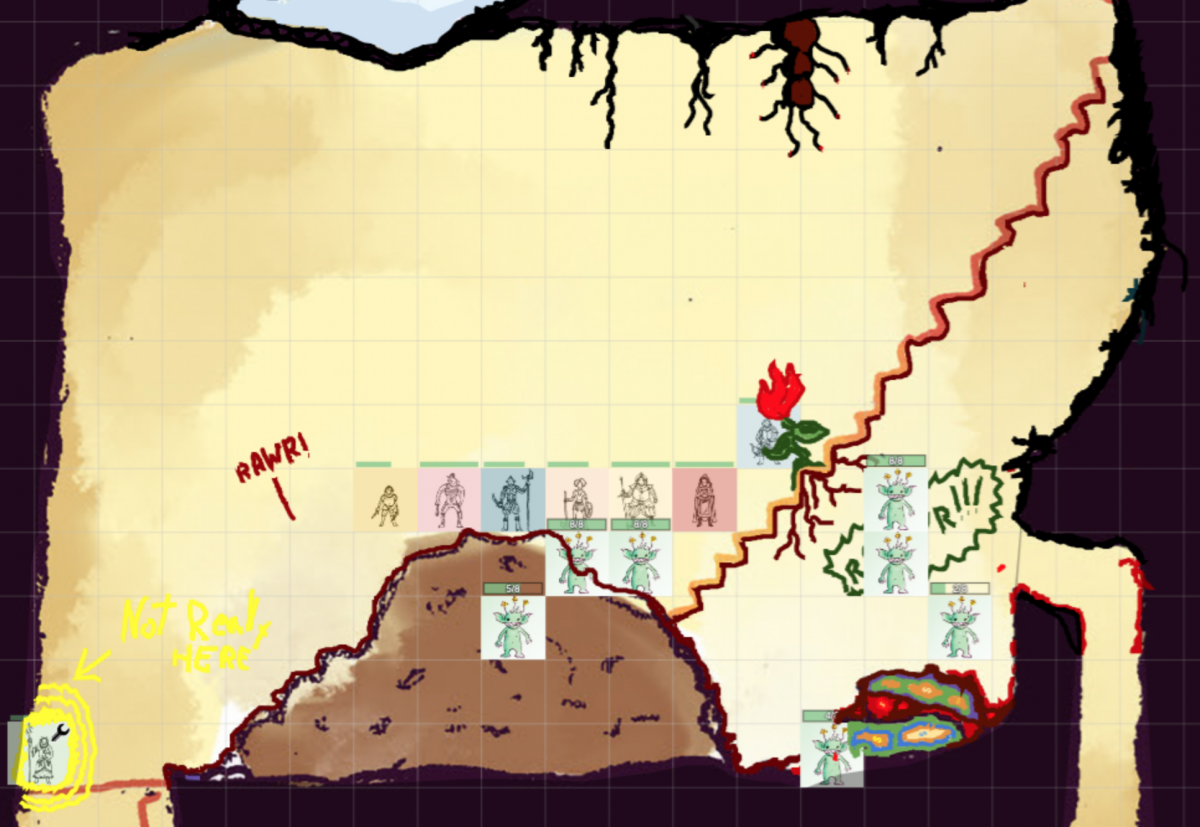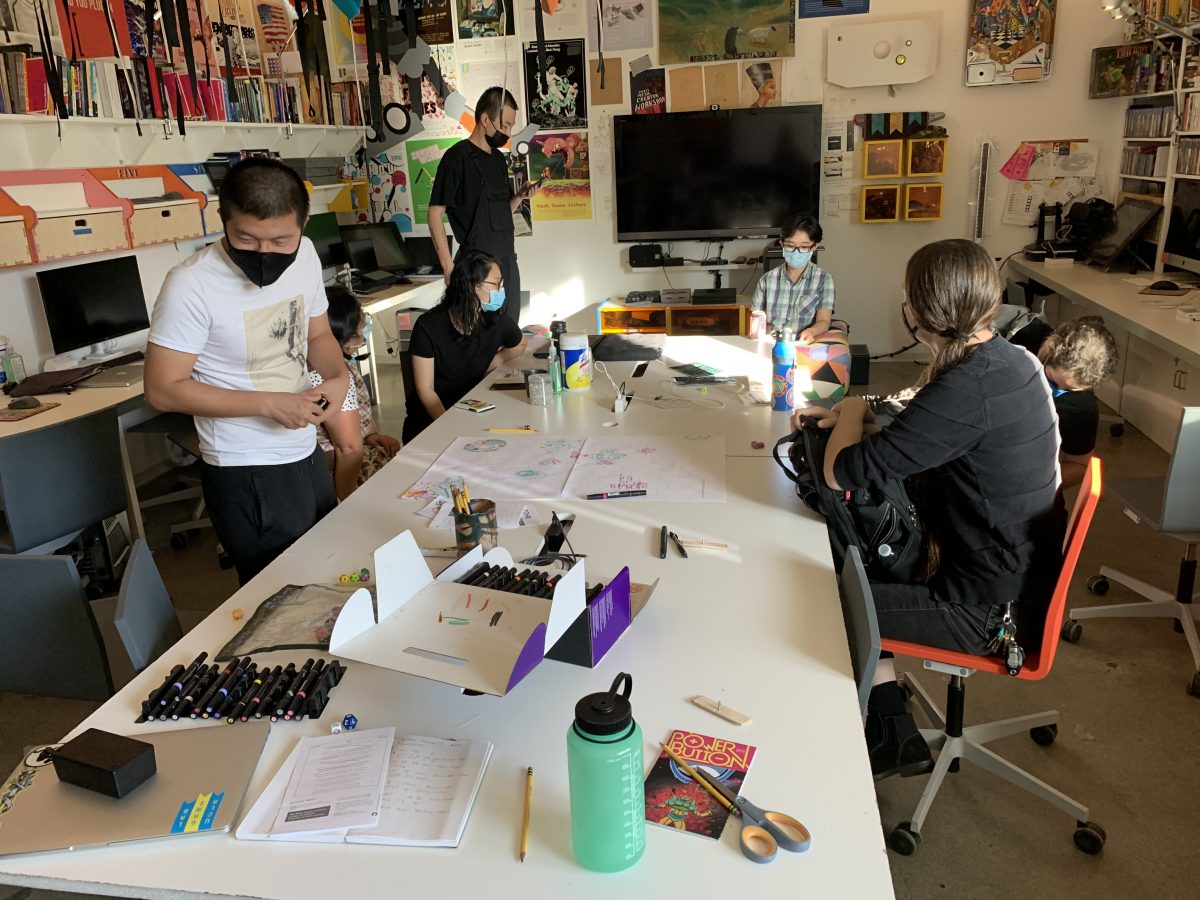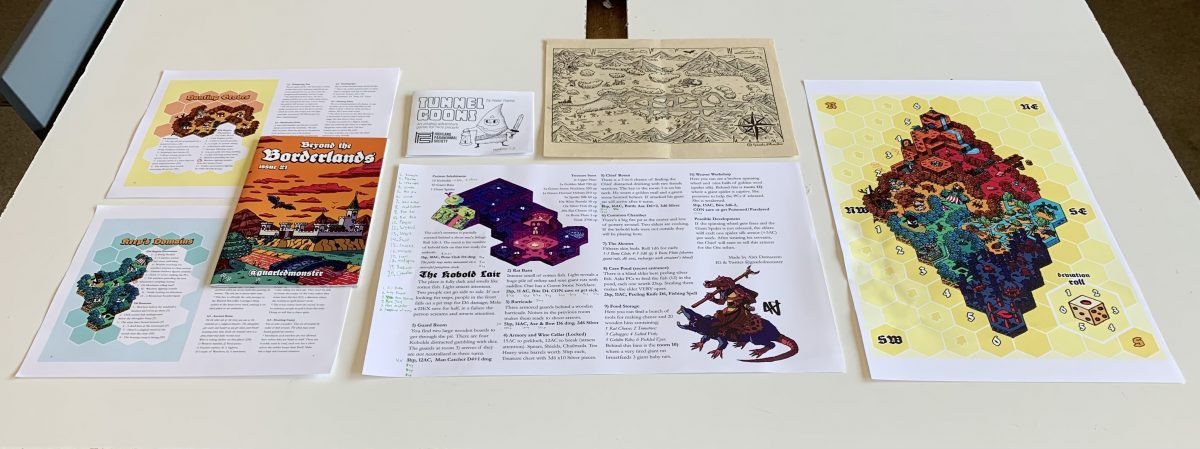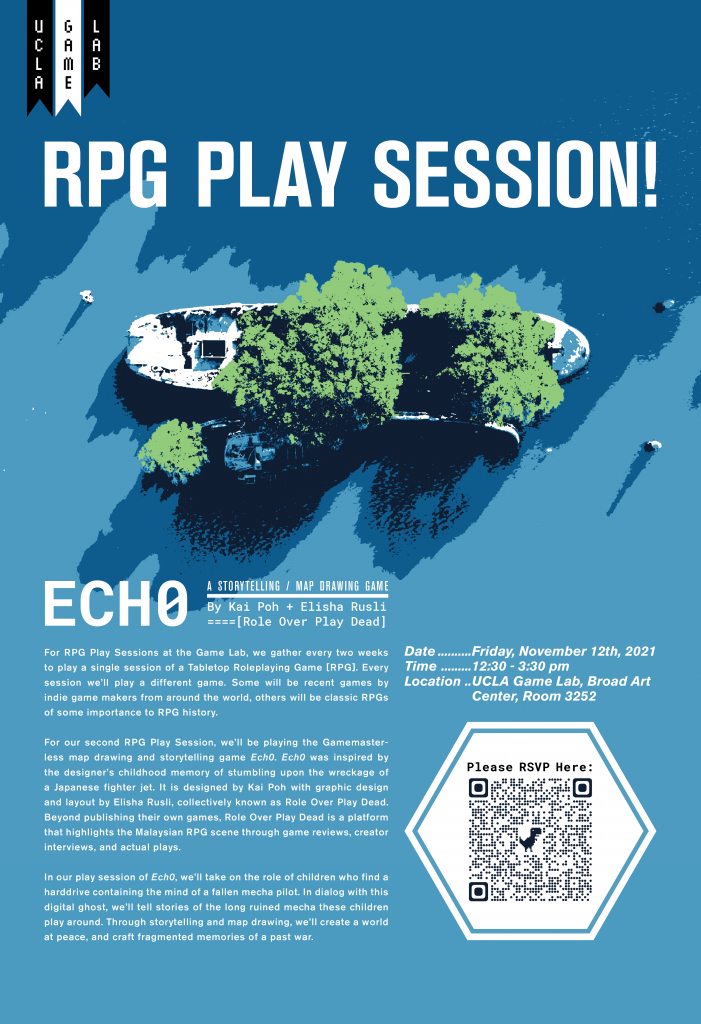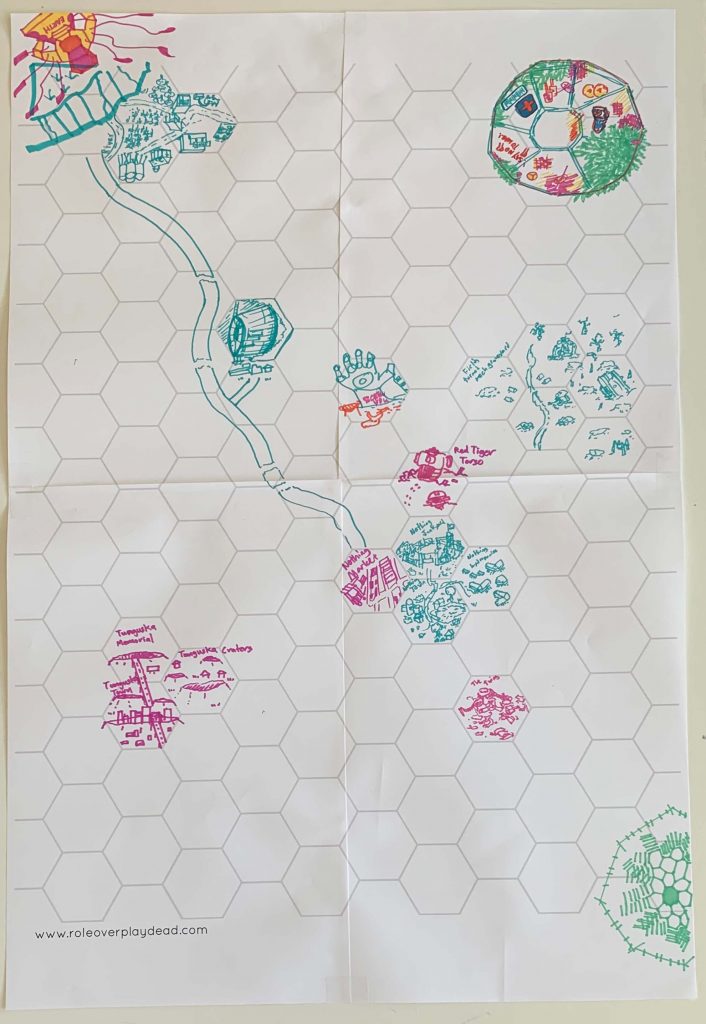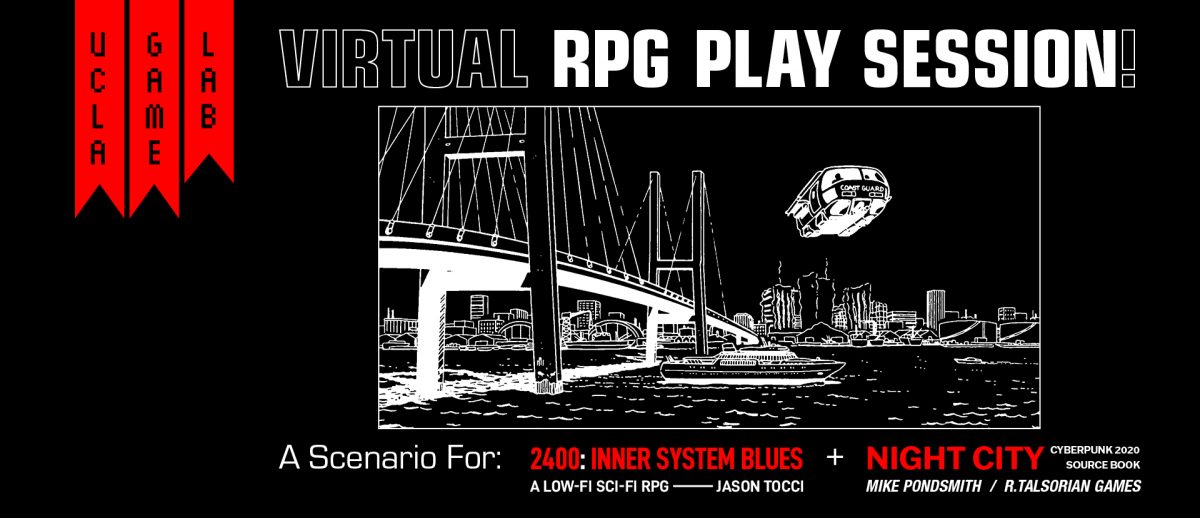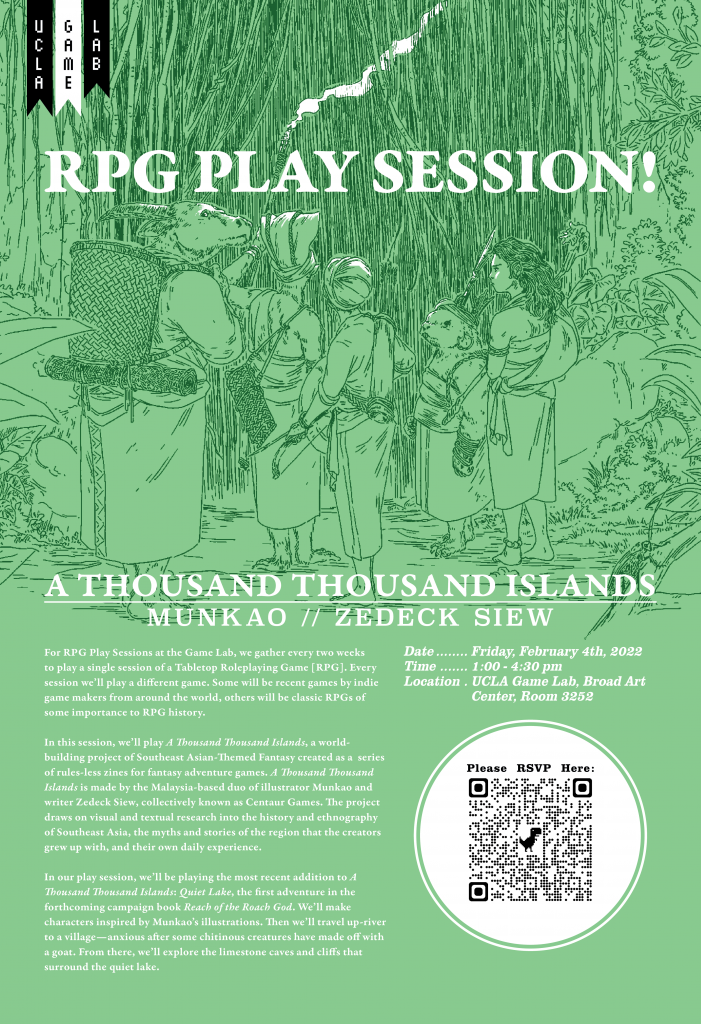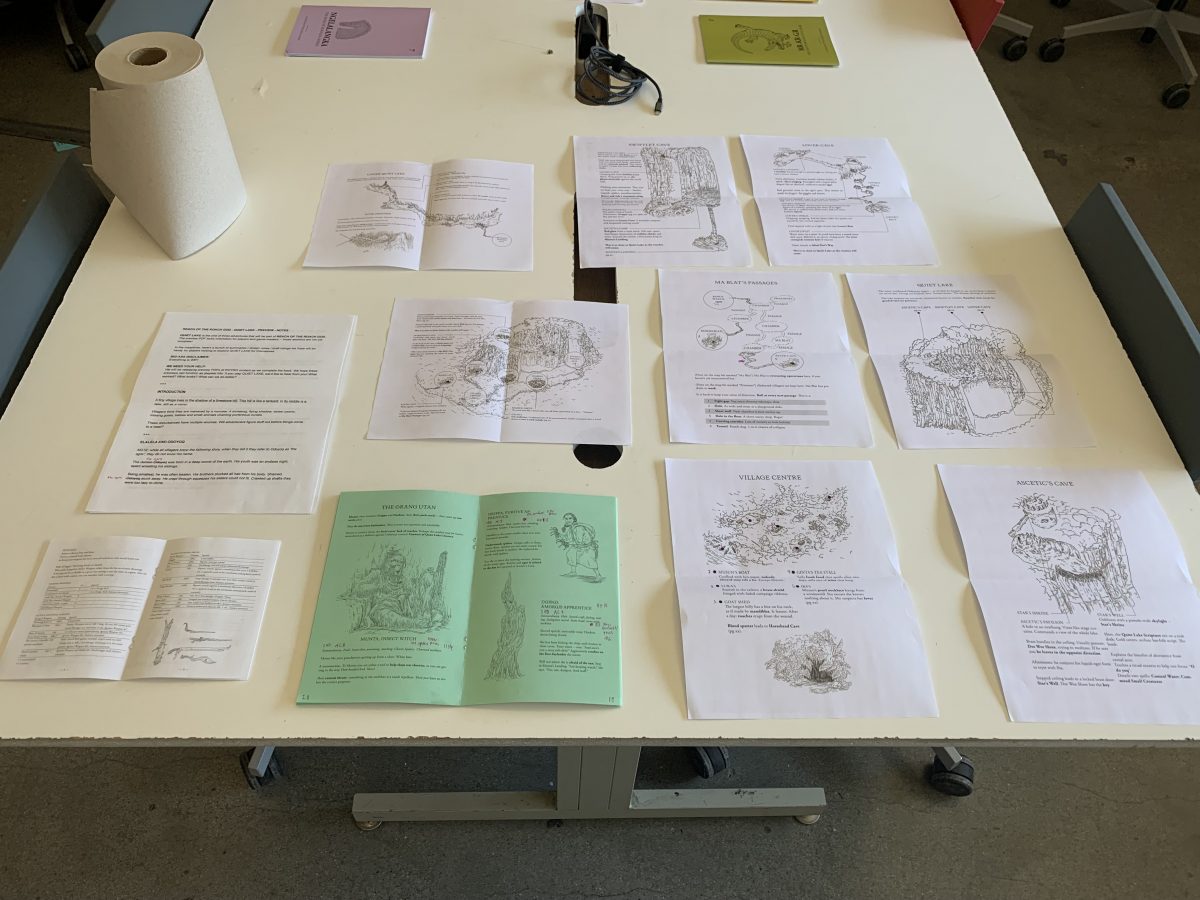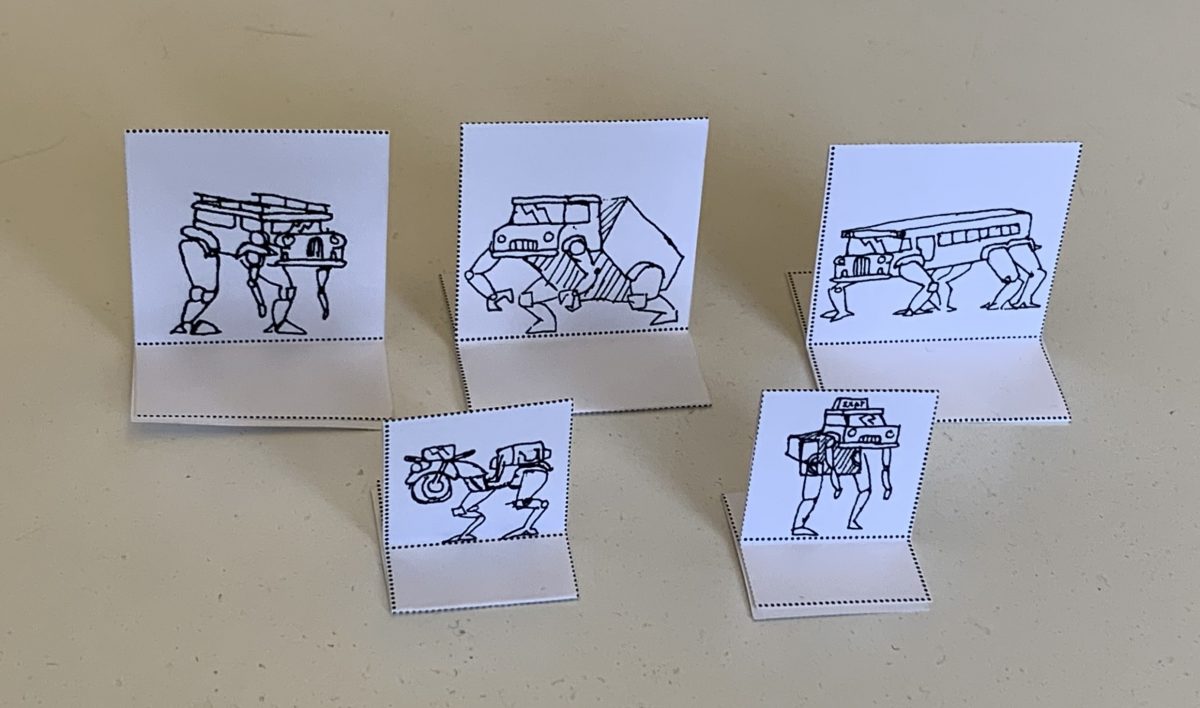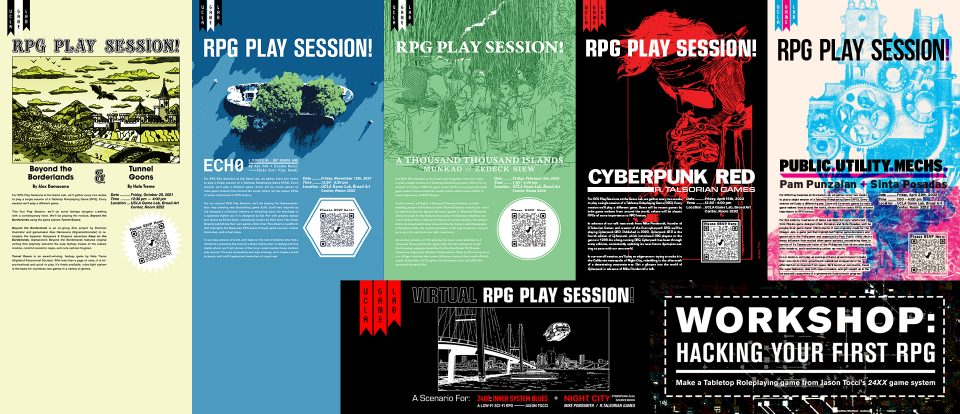
RPG Play Sessions at the Lab 2021-2022
Posted on October 4th, 2022
by Meet Em Up Team
In 2020, we began to host remote RPG game sessions at the game lab. In both a few sessions of Jason Tocci’s one page Dark Souls inspired RPG, Exhumed, and a long running campaign of Goodman Games’ Dungeon Crawl Classics[DCC]—run in a way that anyone could join in each week and continue an ongoing exploration of a vast dungeon, in this case the Lost City of a classic D&D module by Tom Moldvay—our goal was merely to have a space to play and socialize during the campus closures. In that, these sessions succeeded, bringing together current grad and undergrad students, staff, faculty, and lab alums—often for the first—to play some fantasy RPGs . This interest in Tabletop Roleplaying Games bled over into our remote classes. Large, many player sessions of DCC, Nate Treme’s Tunnel Goons, and Jared A. Sorensen’s Action Castle, became mainstay play sessions in The Game Design Workshop class. Eventually this culminated in a version of Game Design Workshop focused primarily on RPGs, students made One Page Dungeons, RPG rule sets, and implemented both in the virtual tabletop platform Roll20 that we’d used to run our virtual play sessions. All of these RPGs were compiled in book archived at the Lab and sent out to the students.
This academic year, with the return to campus, we set out to delve deeper into the realm of RPGs in two main ways: the first was by expanding our RPG collection by acquiring indie, experimental, or small-team made RPGs for the game lab library; and the second is the subject of this post, running regular play sessions of indie RPGs in the lab. Unlike our virtual sessions, which were primarily for lab members, these RPGs were open to all in the broader D|MA and UCLA arts community and would hopefully serve as a first connection to new people curious about the lab. Further, instead of running a longer campaign, these sessions would be one-offs, with each session highlighting different games each time. We hoped to focus, like with the games we were collecting for the library, on indie games made by solo-game makers or small teams of, for example, one writer and one artist. As the year continued, the new game lab student events group, Game Lab Meet ‘Em Ups, invited some of these creators for artists talks. We’d a play a game from these artists before their talks, so interested people could experience the artists’ games in play. We also ran multiple sessions of Cyberpunk Red before Mike Pondsmith’s visit to the D|MA department.
In the 2021-2022 academic year we held six RPG play sessions and one RPG making workshop. For some of these sessions, there are longer session summaries on the game lab blog detailing our actual play experience. Our hope with all these sessions was to give these games place to shine by seeing them in play, whether that meant picking the right rule set for a given adventure, devising a scenario for a given rules system, or even hacking our own system to fit our interpretation of module:
In the first quarter, we hexcrawled through Alex Damaceno’s [@GnarledMonster, Brazil] Beyond the Borderlands—modern re-imagining of a classic D&D module Keep on the Borderlands—using Nate Treme’s [@NateTreme, US] rules-light fantasy game Tunnel Goons, and built a world at peace in Kai Poh and Elisha Rusli’s [Role Over Play Dead, Malaysia] collaborative storytelling and map drawing game Ech0. In Beyond the Borderlands, our six strong gang of goons explored Damaceno’s colorfully rendered Wicked Paleovalley and double-crossed their benefactors to help a band of captured Kobolds. You can read a more detailed summary of our session here. In Ech0, our junkyard hangout friend group of 7 kids, 1 sentient slime, and 1 youthful appearing robot, gave the harddrive-bound, data-ghost of fallen mech pilot a final tour of the land they fought and fell in so long ago, before laying him to rest in graffitied hideaway made from the rusted frame of their own military machine. Read more about this session here.
In the second quarter, we returned to remote play, doing an online session of Jason Tocci’s [@pretendogames, US] 2400: Inner System Blues, and in collaboration with Meet ‘Em Ups we hosted a remote workshop on hacking tabletop RPGs. Inner System Blues is a one page cyberpunk RPG, one of many games from Tocci’s 2400 project, that is both a series of sci-fi games and framework that other creators can use to make their own rules-light games. For our session, we played an original scenario I devised and mapped out in Roll20 for the Cyberpunk and its Discontents graduate seminar. The scenario was set in Night City, the famous California Metropolis from the second edition of R.Talsorian Games’ Cyberpunk, Cyberpunk 2020. Our down-on-their-luck gang of Cyberpunks, Cyborgs, Androids, and Psychics was hired by the amicable office administrator of a scientific and maritime research corporation to steal something from the back of a truck. Only after accepting the job and arriving at the site of their heist, did they learn that their quarry belonged to the NorCal navy. Chaos ensued as our gang coordinated over their agents to break into the truck, locked-down with armed anti-theft car alarm defense system [a standard feature in most cars in Cyberpunk’s collapsing and militarized US], while the exoskeleton clad drivers grabbed a artificial burger in a nearby food court. When they finally broke into the truck, they discovered that their objective was a navy dolphin, rigged up with a high powered laser and a brain wired screen for emote communication. Chased by the trucks guards, they used psychic trickery and the dolphin laser to make their escape, speeding in their hacker-pad van to the Night City pier to free this dolphin deserter. The session ended with a happy Dolphin returned to open ocean and the looming threat of corporate revenge for our cyberpunk’s rebellion. In our workshop, we relied again on Jason Tocci’s 2400 system as the basis for beginning to draft our own games, using the 2400 system reference document [a paired down version of the game, made with annotations to help in making your own games] and my own hack of 2400 made for the 24XX jam. I spoke about the utility of hacking a game, versus making a system from scratch, and went through the process of altering 2400, for my own version 24XX: Prepared Foods, that used this sci-fi adventure game framework for making a game about working in the prepared foods department of a grocery store. We then began to work together drafting our own RPGs, drawing from a wide array of experiences: interviewing for a Corporate Job in the games industry, getting groceries on the eve of lockdown, and roaming city streets as stray and wild animals. For each game we devised new methods of character creation, altered core mechanics to fit these radically different premises, and did worldbuilding through randomized encounter tables.
In the third quarter, each of our play sessions was tied into an artist talk from the creator[s] of the RPG we played. In the lead-up to a talk from writer Zedeck Siew entitled What does a dagger look like to you? That dealt with using language to recenter fantasy, we played the module Quiet Lake from Zedeck and Munkao’s[@RunWithCentaurs, Malaysia] ongoing South East Asian fantasy zine project A Thousand Thousand Islands. You can read more about that session here, and the artist talk here. After that, the Design | Media Arts department and the Game Lab brought renowned RPG designer Mike Pondsmith for a visiting lecture, and in preparation we ran two sessions of the introductory scenario for R.Talsorian’s[@RTalsorianGames, US] latest edition of Cyberpunk, Cyberpunk Red. The scenario, The Apartment, centers around the characters owning and maintaining an apartment building. After meeting their eccentric neighbors, this home—the Edgerunners only source of stability in this collapsing cyberpunk dystopia—comes under threat from the secret machinations of a telecom corp who want to demolition the apartment to build a communication tower. One session culminated with an impromptu rock show on the building’s roof in a attempt to stall the corpo demolition team, while the other ended with a breakneck chase through the apartment as the Edgerunners scrambled to capture a netrunner sent to sabotage the building’s systems. In his lecture, Pondsmith spoke of the centrality of neighborhoods to his design of Cyberpunk and Night City. The apartment scenario exemplifies this ethos, though the characters may not be able to change the whole world, they struggle to protect their community and those closest to them. In our last session of the year, we played Pam Punzalan[@TheDovetailor, Philippines] and Sinta Posadas’s[@diwataMANILA, Philippines] Public Utility Mechs[PUM], in advance of their talk about designing games from lived experience. PUM draws from Posadas’s experience of commuting via Jeepney in Manila. Jeepneys are a public transportation mode unique to the Philippines, owner operated buses originally converted from surplus US military jeeps sold off at the end of the American Colonial Period after World War II. PUM brings this concept into a scrappy vision of the future, where in the aftermath of a global alien invasion, the government offers licenses to allow everyday Filipino to convert their vehicles into transforming mechs. The game deals with resiliency of these citizen mech pilots and criticizes the bureaucratic corruption and inefficiency of this government run mech program, while also using this sci-fi alien invasion as a metaphor for colonialism. In our session, our small convoy of PUM pilots traveled the ill maintained highways—neglected by the political class in their walled metropole bastions—as they transported an elderly couple to a pilgrimage site near the ailing husbands rural birthplace. On this journey we had many encounters generated from PUM’s evocative random table’s, haggled at one of the many government run scrap yards that are an important site of bureaucratic inconvenience in PUM’s speculative world, and engaged in fast-paced grid combat with the alien invaders, called ironically Our Friends.
Although tabletop RPGs are of great significance to the history and conventions of game design and game making, these game forms, especially recent developments in the indie RPG space, are often overlooked. In our play sessions this year, we hoped to give just a small sample of these games—being made and released now by creators from many different places and backgrounds—a space to be experienced in play. As was emphasized by the creators themselves who spoke with us in Meet ‘Em Ups, RPGs are a unique game form relying heavily on the interpretation of the player at each and every table both in preparation and in play. For me as the person preparing and running these game sessions, I can say that I had a dramatically different experience of each of these works through running them and preparing them for play, whether that was sketching transformed taxi’s to make standee miniatures to facilitate PUM’s fast paced mech combat, or reading cyberpunk fiction with an eye towards interesting encounters and game elements I could pilfer for Inner System Blues. The players also brought their own elements to each session, creating eccentric characters for these fictional places, devising zany and rebellious schemes, and building worlds through play. Perhaps of equal importance to RPGs is the social aspect of play. It was great that a shared curiosity about these different games could grow the Game Lab community in a way they weren’t able to online, with a student and lab faculty member meeting for the first time as they built futuristic sci-fi setting, or a new students first social event in the department being spent delving the caverns beneath a lakeside village. As the mission of the Game Lab is to encourage new modes of expression in gaming, it is the hope that experiencing this sample of different games from an on-going and lively gameform and hearing from the creators themselves, will encourage new modes game making, experimentation, and thinking of play forms for the students and artists who participated.

